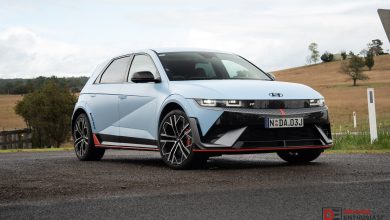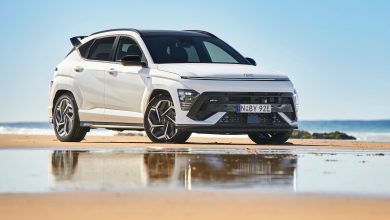Hyundai’s all-new IONIQ 9 arrives as the brand’s flagship electric SUV, introducing three rows of battery-powered versatility into the growing EV space.
Built on the same E-GMP platform as the Kia EV9, it aims to offer a luxury experience without the luxury price. But, that price in question pushes $120,000. Is it a convincing option for Aussie buyers?
For reference, during the first six months of this year Kia sold just 165 examples of the EV9 in Australia. That’s a lot less than the 5165 Sorento models it sold in the same period. This could be a tough sell for Hyundai.

2026 Hyundai IONIQ 9: Specifications
Battery: 110.3kWh lithium-ion, 800V
Output: 314kW / 700Nm
Gearbox: Single-speed auto
Drive type: Four-wheel drive
Wheels: F & R: 21×9.0, 285/45
Kerb weight: 2744kg
Power-to-weight: 8.73:1 (kg:kW)
Official range (WLTP): 600km
Max charging AC/DC: 10.5kW/350kW
0-100km/h: 5.08 seconds*
Starting price: $119,750
*Figures as tested by Driving Enthusiast on the day. Manufacturers’ claims may be different

2026 Hyundai IONIQ 9: How much does it cost?
Hmm, so here’s the thing. This starts from $119,750. That makes it $38,031 more expensive than the most expensive Hyundai Palisade. A vehicle that does pretty much exactly the same thing as this, with similar interior space and quality. Wait until the new Palisade arrives as well, which amps things up even further in terms of efficiency and interior refinement.
As a result, it is very difficult to find a reason to pay this much extra for such a vehicle. Aside from it uses no fuel, but you will have to change you ‘refuelling’ habits to some degree if you’re jumping out of a combustion vehicle, which could incur some initial costs (setting up a home charger/solar panels and so on).
Rivals? Well, it has the Kia EV9 which tops out at $121,000 for the GT-Line, and the Volvo EX90 which starts from $134,990. At least with the Volvo it is a proper premium offering – and is quicker – so the price (almost) makes sense.

2026 Hyundai IONIQ 9: Interior & packaging
Stepping inside the IONIQ 9 and you’re greeted by a sense of space and serenity, but, it doesn’t quite match the expectations set by the $120k price tag. The cabin is undeniably expansive, thanks in part to the long wheelbase and flat floor made possible by the E-GMP architecture.
The third-row seating is usable for adults in short stints, and access is aided by an electric fold-and-slide second-row. Buyers can opt for either a six- or seven-seat layout, with the six-seater introducing a unique sliding centre console and recliner-style relaxation chairs in the middle row.

Up front, dual 12.3-inch curved screens give the dashboard a high-tech look, and the Connected Car Navigation Cockpit infotainment system brings OTA updates, Google Places search, and natural voice command recognition.
It’s all slick and impressively functional. However, the cabin materials – while tidy and thoughtfully laid out – lack the sense of occasion you’d expect in a premium flagship. Nappa leather and ambient lighting elevate the ambience slightly, but hard plastics on lower surfaces and for the switchgear that feels more Tucson than Genesis serve as reminders of Hyundai’s mass-market roots. Nothing wrong with it, but it comes back to the price you’re paying. If this was an $80k vehicle it would make more sense.

Clever features like a UV-C sterilisation compartment, an ergo-motion driver’s seat with air pocket adjustment, and a panoramic roof are welcome, but, again, they can’t completely compensate for the interior’s shortfall in perceived luxury for this price.
Boot space is rated at 338L with all rows up, expanding to 908L with the third row folded. Compared with the current Palisade, it offers 311L and 1297L, opening to 2447L with both rear rows down. This does benefit from an additional 52L compartment under the bonnet, however.

2026 Hyundai IONIQ 9: Powertrain & handling
Under the skin, the IONIQ 9 is based on the wider group’s E-GMP architecture as mentioned, offering up to 800V charging capability. There’s a 110.3kWh battery stuffed into the floor (larger than the EV9’s 99.8kWh unit), sending energy to dual electric motors to produce a total output of 314kW and 700Nm.
Even with the hefty kerb weight of 2744kg, this beast shifts along with serious acceleration. Hyundai claims 0-100km/h takes 5.2 seconds, and I found a quiet straight bit of road to come up with a real-world figure of 5.08 seconds, using a Vbox.

There’s also a strong mid-range shove, with 80-120km/h dispatched in just 3.4 seconds – handy for overtaking or merging onto highways. There is no combustion non-premium SUV currently on the market that offers this level of acceleration, in this class. And this is the main (and potentially single) area where the price is somewhat justified.
Hyundai’s engineers have done an admirable job tuning the chassis. Despite the sheer size and weight of the IONIQ 9, it feels composed and relatively agile on winding country roads. The suspension – MacPherson strut front and multi-link rear – keeps the body well controlled, and the ride comfort is impressive, soaking up Aussie country roads with minimal fuss. It doesn’t quite offer the quicker-reacting braced feel like you get in a lighter weight SUV, but this is good for this style of vehicle. A nice balance between comfort and handling.

The AWD system ensures solid traction in all conditions, although there’s no real off-road pretence here. You can barrel into a corner and apply loads of throttle from the midway point and the clever and instantly-responding e-motors jump to the task of propelling the vehicle away from the corner in a controlled and sure-footed manner.
Regenerative braking is smooth and adjustable via the paddle shifters, and Hyundai’s trademark smooth throttle calibration makes low-speed driving easy and refined. Some EVs are very sudden off the line due to the immediate power delivery available in electric setups. But not here. It’s clear a level of tuning has been applied to provide a natural and progressive feel.
Importantly, the range claim of 600km (WLTP) seems close-to-achievable in ideal conditions, although having things like the air-con on will reduce the figure. At max charging it can go from 10–80 per cent in 24 minutes with a 350kW plug – provided you can find a charger that delivers on its promise and isn’t out of order. That’s a whole new discussion though and not necessarily a problem with the vehicle, even though you might have to deal with such scenarios because of the vehicle.

2026 Hyundai IONIQ 9: First impressions
The 2026 Hyundai IONIQ 9 is an impressive technological showcase and a milestone for the brand. It delivers on space, refinement, and EV range, with enough power and comfort to handle family duties with ease.
But whether that’s enough to sway Aussie buyers into a $120k Hyundai remains to be seen – especially when there are plenty of 7-seat SUVs out there that do pretty much the same thing as this (aside from 5.2s 0-100) for about $40,000 less. This is probably going to struggle to find an audience, just like the EV9. At least for the time being.





















